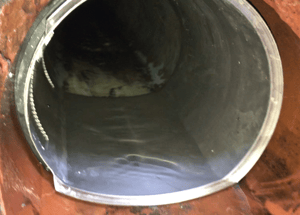 CIPP has become the industry standard for relining pipes, but it’s not a perfect solution. CIPP liners often shrink after curing in response to variations between cure and ambient temperature. The annular space between the liner and host pipe can allow ongoing infiltration, becoming a groundwater expressway that carries leakage directly from the source to the manhole. While closely monitoring the cool down process and lowering the temperature before releasing pressure can help prevent shrinkage, it can also add time and expense to an already pricey repair process. To prevent this, many installers utilize a liner end seal.
CIPP has become the industry standard for relining pipes, but it’s not a perfect solution. CIPP liners often shrink after curing in response to variations between cure and ambient temperature. The annular space between the liner and host pipe can allow ongoing infiltration, becoming a groundwater expressway that carries leakage directly from the source to the manhole. While closely monitoring the cool down process and lowering the temperature before releasing pressure can help prevent shrinkage, it can also add time and expense to an already pricey repair process. To prevent this, many installers utilize a liner end seal.
The most popular type of end seal for CIPP liners is a hydrophilic liner made of rubber and held in place with stainless steel bands. These end seals are installed before the liner is inverted into the line. The stainless steel ensures that the seal doesn’t shift during the inversion process. These seals work by absorbing any water that comes in contact with them, swelling and filling annular space at the liner ends. When installed and maintained, these types of seals work well. However, without maintenance, when installed incorrectly, or under less than ideal conditions, these seals can fail. And, with the seal trapped between the cured liner and host pipe, the only repair option is to cut out your seal and liner and replace the entire section.
Are there any other options? Mechanical end seal sleeves installed on top of the liner after curing are the best alternative. These sleeves consist of an EPDM rubber sleeve and a stainless steel cuff with a flare at one end. The rubber seal is slipped over the steel cuff, and a pneumatic balloon packer is used to expand the cuff, pressing the rubber seal against the liner wall. The flared end of the steel cuff completely covers the manhole-end of the liner, compressing the rubber to seal out infiltration.
 A mechanical sleeve installed on top of your liner provides a few advantages. First, it ensures that the liner won’t displace the sleeve during installation. Second, the sleeve can be easily removed in case of improper installation, damage or failure. Mechanical sleeves often use ratcheting gear locks to secure the steel cuff in place. Depending on the configuration of the cuff locks, removal can be as simple as cutting the gears. Once the locking gears are severed, the cuff will collapse in, and the cuff and rubber seal can be pulled out, leaving the liner and host pipe underneath undamaged.
A mechanical sleeve installed on top of your liner provides a few advantages. First, it ensures that the liner won’t displace the sleeve during installation. Second, the sleeve can be easily removed in case of improper installation, damage or failure. Mechanical sleeves often use ratcheting gear locks to secure the steel cuff in place. Depending on the configuration of the cuff locks, removal can be as simple as cutting the gears. Once the locking gears are severed, the cuff will collapse in, and the cuff and rubber seal can be pulled out, leaving the liner and host pipe underneath undamaged.
Another advantage to mechanical sleeves is the protection they provide to the edge of the liner. Over time, the edge of a liner, particularly the portion in the flow path, can wear down due to maintenance work, debris or flow. This can prove damaging to both the liner integrity and the end seal. Utilizing a mechanical sleeve that covers the edge of the liner protects it from wear and tear. And, if the sleeve degrades to the point of failure, it can easily be replaced with a new one.
Regardless of which type you choose, end seals are a must for reliable CIPP liners. A mechanical end seal sleeve provides easy-to-install, reliable infiltration abatement and liner end wear protection that can be replaced if needed. Still not convinced? Request a demo of the Quick-Lock end seal to see the benefits for yourself.
